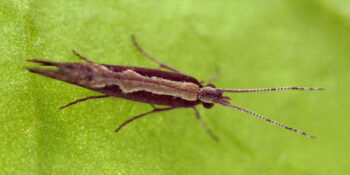Biology and occurrence
Globally the diamondback moth, Plutella xylostella, is a serious pest of brassica crops but in the UK it is sporadic. There was unusually high levels of it in 2017 and so it is good to keep an eye out for it.
Diamond-back moth may infest crops throughout the UK and the larvae can cause damage to the foliage of cabbage, cauliflower, broccoli, Brussels sprout, kale, Chinese cabbage, swede, turnip, oilseed rape and radish. Large infestations can cause damage to up to 100% of plants but yield losses will depend on the impact of damage on plant growth and quality. Good control is particularly important where the marketable part of the plant is damaged (cabbage, cauliflower, broccoli, Brussels sprout). Plants with low levels of damage usually survive but this may affect uniformity within the crop.
The rate of development of diamond-back moth is dependent on temperature, so more generations will be completed in warm locations. In the UK, depending on when moths arrive, there may be two to three generations per year. Eggs may hatch within 2–3 days of being laid and a complete generation takes about 5 weeks at 15°C.
The eggs are yellow and laid singly or in small groups, mainly alongside the mid-rib or leaf veins. The larva is light green and has a tapering body that is widest in the middle. Larvae that are disturbed wriggle violently. Fully grown larvae (15 mm) construct a flimsy cocoon on the leaf surface before developing into a pupa about 9 mm long. The larvae destroy the foliage of most types of brassica crop. They generally eat almost all leaf material except the upper epidermis, which makes the leaves appear as if they are covered by lots of windows. Large infestations will destroy the leaves entirely. They will damage plants of any age.
Management Options
Good control is particularly important where the marketable part of the plant is damaged (cabbage, cauliflower, broccoli, Brussels sprout). Plants with low levels of damage usually survive but this may affect uniformity within the crop.
Brassica crops can be protected by covering with netting.
Although there are insecticide resistance problems in other parts of the world, there is no evidence at present that the moths migrating into the UK each year are highly resistant to the insecticides approved in the UK for diamond-back moth control.
Information and image from Rothamsted's Croprotect webpage supported by BBSRC NERC Sustainable Agriculture Research & Innovation Club







